NGC 2392
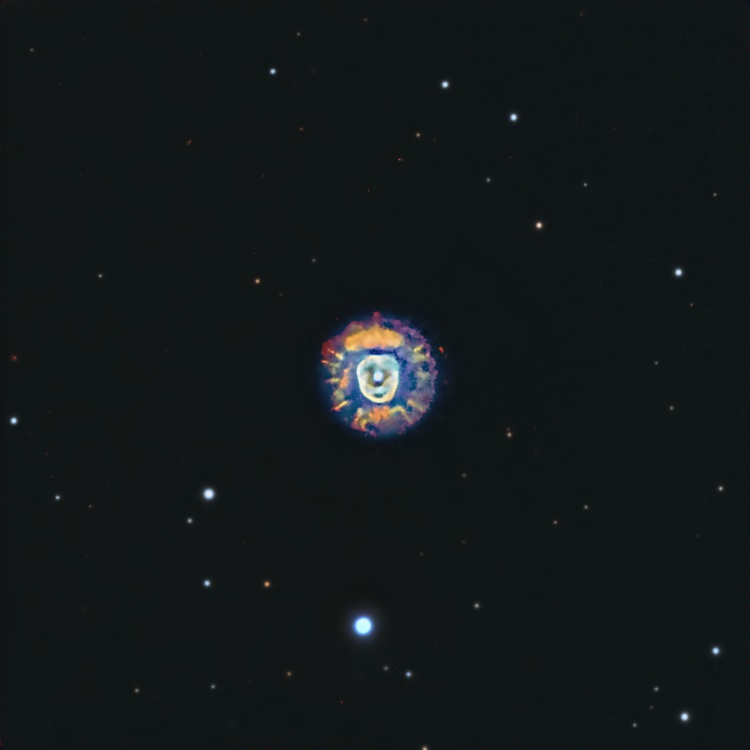 Click image for full size version
Click image for full size version
February 23, 2025
NGC 2392 is also called the ‘Clown-Faced Nebula.’ It is a small planetary nebula of glowing gas in Gemini. This object is about 6,500 light years away and can be seen in a small telescope. It’s small size (diameter is just 48 arcsec) makes it a good target for long focal lengths. The image above used narrowband sulfur, hydrogen and oxygen emissions to make a false color palette, with the stars coming from broadband red, green, and blue filters.
Tekkies:
Acquisition, focusing, and control of Paramount MX mount with N.I.N.A., TheSkyX. Guiding with PHD2. Primalucelab low-profile 2″ Essato focuser, ARCO rotator and Giotto flat panel. Equipment control with PrimaLuce Labs Eagle 4 Pro computer. All pre-processing and processing in PixInsight. Acquired from my SkyShed in Guelph. Above average transparency and average or better seeing. All the data for this image was captured on data acquired in a moonless sky, all on the night of Dec. 1 – 2, 2024. I’d have liked more data for this target, but no clear skies here since early January.
Celestron 14″ EDGE HD telescope at f/11 (3,931 mm focal length) and QHY600M-SBFL camera binned 2×2 with Optolong filters.
9x5m Red = 0hr45m
7x5m Green = 0hr35m
8x5m Blue = 0hr40m
11x5m S2 = 0hr55m
13x5m Ha = 1hr05m
13x5m O3 = 1hr05m
Total: 5hr05m
Preprocessing: The WeightedBatchPreProcessing script was used to perform calibration, cosmetic correction, weighting, registration, local normalization, integration, and auto-cropping.
Broadband Colour Master: A colour master was made from the Red, Green and Blue masters using ChannelCombination in RGB mode.
Gradient Removal: DynamicBackgroundExtraction was applied to the RGB master.
Colour Calibration: ColorCalibration was used to calibrate the RGB master.
Deconvolution: BlurXterminator was used on the RGB master with Automatic psf at default settings.
Linear Noise Reduction: NoiseXterminator was applied to the RGB amaster with settings Amount=0.9 and Detail=0.35
Star Removal: StarXterminator was used to remove the stars from each of the RGB and narrowband masters, with default settings. Only the RGB stars-only image was preserved.
Hubble Palette Image Creation: The H and O masters were balanced to S using LinearFit and combined using ChannelCombination in RGB mode.
Stretching: HistogramTransformation was applied to the RGB, SHO and narrowband masters to make pleasing images. Approximate background level after the stretches was 0.10 for RGB and SHO and 0.09 for the individual narrowband masters.
Nonlinear Processing
Nonlinear Noise Reduction: NoiseXterminator was used to reduce noise in the background areas of the RGB and SHO masters with settings Amount=0.9 and Detail=0.15. Dynamic Range Compression: The CreateHDRImage script was used to compress the core of the nebula in the SHO master, using a mask made with the RangeSelection tool.
Contrast Enhancement: LocalHistogramEqualization was applied twice to the SHO master. A Contrast Limit of 1.5 and 1 iteration was used for each LHE application (scale 150, strength 0.25; scale 50, strength 0.22).
Sharpening: A mask was used to select brighter regions of nebulosity in the SHO master for sharpening with MultiscaleMedianTransform (Layers 2 – 4 with strengths of 0.07, 0.07, and 0.03, respectively).
Hubble Palette Adjustments: CurvesTransformation was used to adjust the colour tones in the SHO image.
Star Processing and Restoration: HistogramTransformation was used to stretch the stars-only RGB image, followed by CurvesTransformation through a star mask to boost saturation using the Saturation slider. The stars were added back into the master images using the Screen blending mode in PixelMath with the expression combine(starless, stars, op_screen()).
Final Steps: Background, nebula and star brightness, contrast, hue and saturation were adjusted using several iterations of CurvesTransformation, with masks, as required. ICCProfileTransformation (sRGB IEC61966-2.1; Relative Colorimetric with black point compensation) was applied prior to saving as a jpg. The finder chart was made using the FindingChart process.

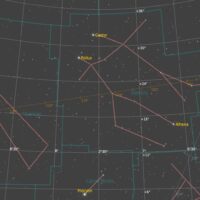
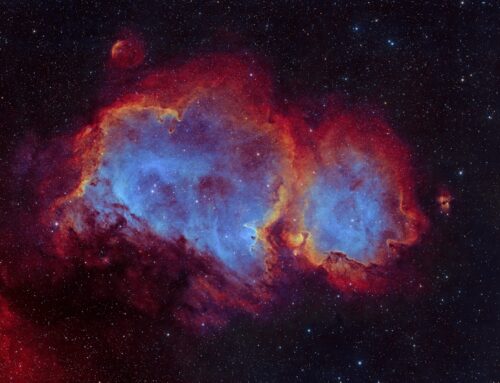

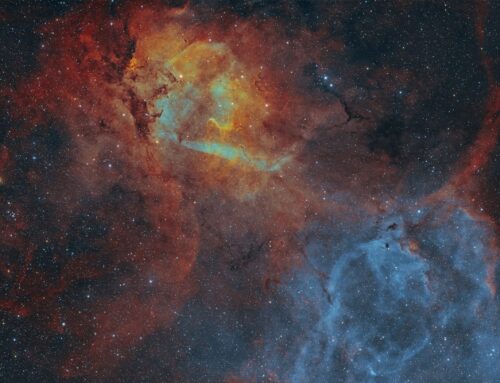
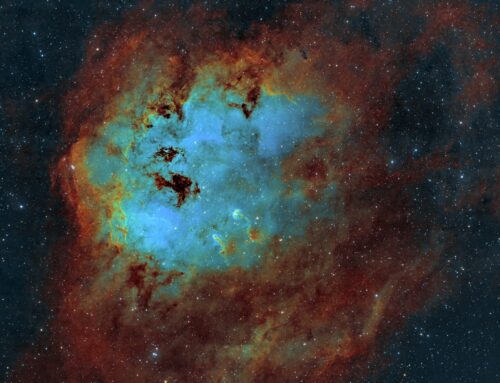
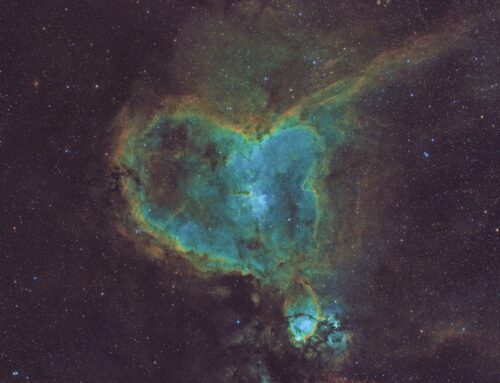
Great capture, Ron.
So cool. 🙂